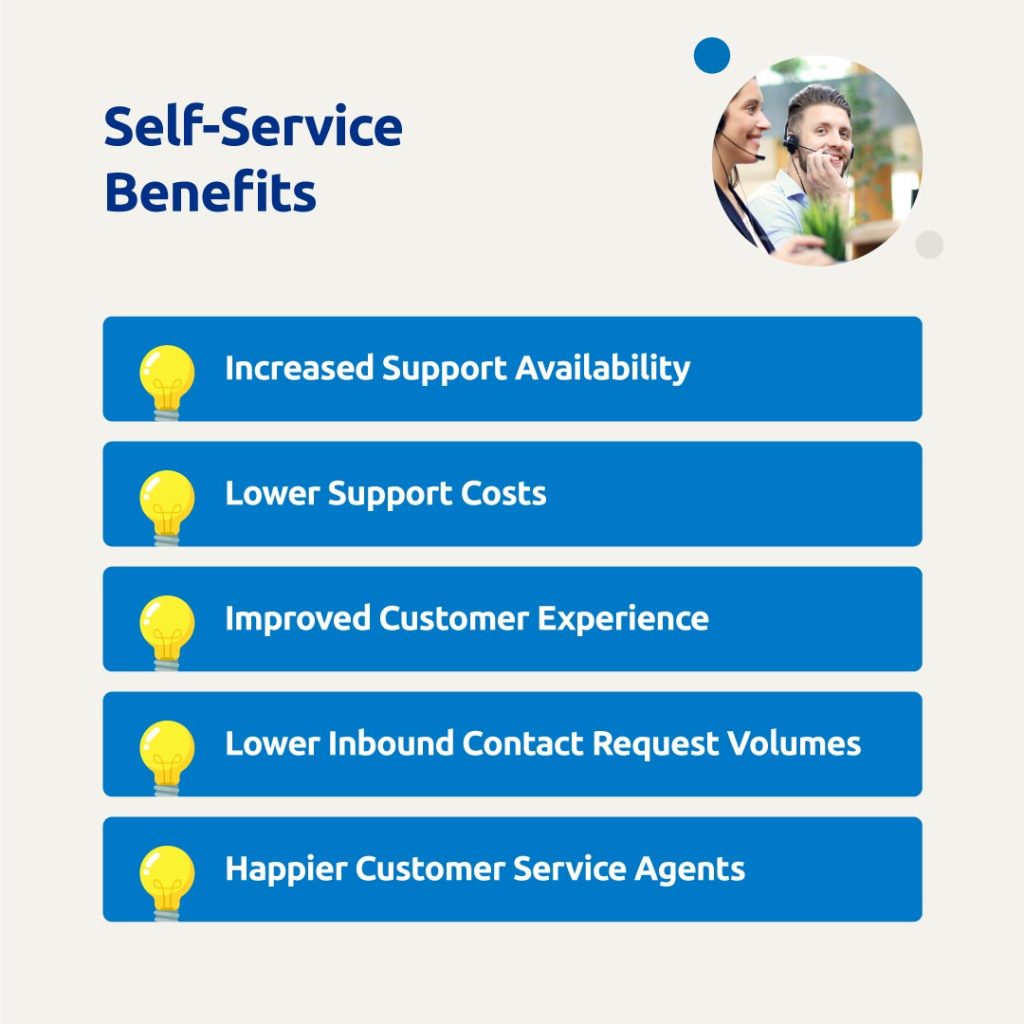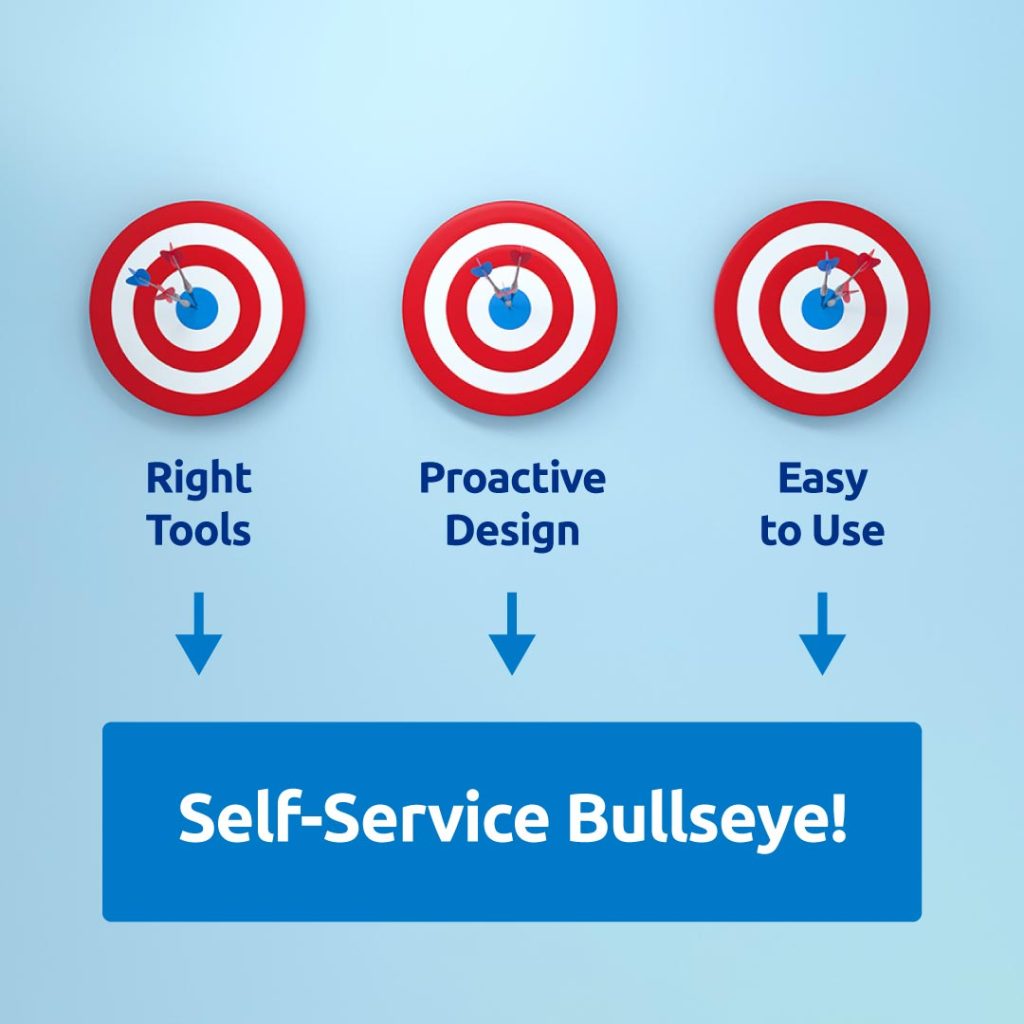In a recent study, business professionals said that their number one priority for the next five years is the customer experience. Adding to this, 67% of customers say that they prefer the option of self-service over speaking to a company representative. Combine these facts together and the value of customer self-service in the digital age is undeniable.
In this guide, we take a closer look at customer self-service and examine how self-support options can boost the customer experience while lowering operational costs. We will also discuss how best to build and enhance your current self-service strategy and how to measure success.
Let’s get started, shall we?
What Is Customer Self-Service?
Customer self-service is any solution your company offers that allows customers to manage the service you offer them with little-to-no live interaction from you or your support specialists.
Self-service is a tool that can be used at any point in the customer journey. Customers can find out information on your value proposition from your website when they’re in the consideration phase. With a strong onboarding setup, they can choose their own options and settings for your products with minimal interaction with your staff. And after-sales support can be greatly enhanced with self-service options.
What Are the Benefits of Self-Service?
Customer self-service offers several tremendous advantages to businesses. When implemented correctly, it can lower operating costs while offering better quality of service, which is the holy grail of customer support.

Some of the benefits of self-service include:
Increased Support Availability
Self-service options are available to customers 24 hours a day, 7 days a week. This isn’t always possible with more expensive support options, such as phone support.
By offering a way for customers to get help whenever they need it, you reduce frustration and limit the chance that they will instead look to a competitor that can offer them the immediate results they seek.
Lower Support Costs
Self-service is one of the prime strategies that reduce customer service costs. Whenever a customer can resolve an issue on their own, it means they don’t need to contact your company through email, phone, or another channel that costs you money.
Typically, self-service options only need to be set up once and have very low operating costs. So, self-service support channels can pay for themselves almost immediately.
Improved Customer Experience
90% of customers expect a company to offer self-service options. Millennials and Generation Zs in particular like to use self-service options, with only 7% saying it’s not important for a brand to offer them.
Improving the customer experience is central to any business’s success. By implementing low-cost, high-availability self-service options, you can boost customer retention and brand loyalty.
Lower Inbound Contact Request Volumes
Across industries, 81% of customers attempt to take care of issues themselves before contacting a live representative.
Every time a customer can successfully solve an issue they’re having through self-service means, it’s another call your contact center hasn’t had to deal with. This can have a knock-on effect as call queues are lower, fewer callbacks are required, and you can even use a smaller number of staff.
Happier Customer Service Agents
Self-service options excel at answering those simple queries that customers have about your products and services, and can also be used to automate many of the mundane things clients want to do, such as change their billing data, username, or contact details.
If you don’t offer a self-service option for them to do it, they must reach out to your contact center. Your agents are inundated with the same queries time and again, which is frustrating and harms motivation.
Agent engagement, where agents are personally motivated to perform their job to the best of their abilities, is vital for keeping agent attrition rates low. Happier customer service representatives result in lower turnover and therefore fewer recruitment and training costs. Agents that stick around longer are more experienced and can offer better customer service.
When you implement robust self-service, agents no longer have to deal with those trivial and mundane requests. Implementing self-service options even just to make your agents’ working lives easier makes a lot of financial sense for your company.
Customer Self-Service Examples
The best customer self-service examples vary by industry. Here are a few to consider for your company:
Knowledge Base
Knowledge bases offer a deep dive into a company’s products and services. They’re typically deployed from a publicly available website, either as part of your main website or as an offshoot. You can also create private, password-protected knowledge bases for your customer base.
6 Reasons Why You Need a Knowledge Base
FAQ Page
FAQ (Frequently Asked Questions) pages are similar to knowledge bases, but their focus is on succinctly offering the most pertinent information on products and services.
Where knowledge bases are designed for a relatively deep dive into the intricacies of the products and services on offer, FAQs are aimed at the customer looking for quick information. FAQ pages should offer short, straight-to-the-point answers and redirect customers to more in-depth replies if they require it.
Knowledge bases and FAQs can be used as the backbone for training in your company, too. As you are keeping your knowledge bases and FAQs up to date with the latest, correct information, your agents can use it for informational purposes when helping customers. They can redirect customers to the information they need or use your FAQs as the basis for email replies.
User Communities
User communities can take the form of on-site forums, feedback portals, and social media circles. You can run a separate social media app on your website for your customers’ use, or leverage existing social media platforms like Reddit, Facebook, or Tumblr.
On-site user communities, when moderated well, can be a goldmine of user-generated content. The constant update of new posted text relevant to your industry is, also, a great boon for search engine optimization, as search engines better rank companies that have up-to-date, engaging content.
They offer you a way to engage with your customers and get a feel for what’s working and what isn’t. People loyal to your brand will champion it, and the social proof this affords you can be invaluable.
Chatbots & Messaging
Chatbots are an excellent way to offer self-service support while maintaining the veneer of live support. The initial few queries from the chatbot can be used to direct customers to the most relevant knowledge base articles for their queries. If this doesn’t help the customer, they can request seamless live chat support through the same interface.
The chatbot can be used to take basic information such as their name and account number, so they’re not required to reiterate it to the live chat support specialist. Not only does this save your agents time and offer them the full details of the customer’s support history on their screen, but it also reduces one of customers’ biggest pet peeves—having to repeat themselves.
Customer Portals
Beyond publicly available knowledge bases with information on products and services, you can create a customer portal for people who have signed up for your services. This portal can be private, personalized, used to upsell more products, and make the customer understand you value their business.
Most importantly, customer portals give your patrons the ability to change their service themselves without ever having to contact your support staff. This can run the gamut from basic account changes to ordering bespoke products through an online design wizard.
Automated Call Centers
Some customers do still prefer to phone companies, but even this can be enhanced greatly with automation. Interactive Voice Response (IVR) allows the customer to make several choices over the phone simply using their voice. This can be used to ascertain the nature of their query so they are directed to the correct department, lowering the number of transfers you need to make.
IVR can be used to automate the process of taking customer details like account numbers, saving you from hiring front-line staff to perform this trivial duty.
Mobile Apps
Mobile apps can be excellent customer self-service applications. Having signed up for your service and downloaded your app, customers can interact with your service using their phones from wherever they are.
Mobile apps are not only great for offering self-service features on the go, but they also help your branding by keeping your company at your customers’ fingertips.
Product Tutorials
Tutorials discussing how to use your products are another potential channel for self-service support. Video tutorials uploaded to your website or YouTube offer an accessible way for new customers to understand your offerings.
Many people prefer to learn by watching a video discussion or seeing a step-by-step guide of someone using the products and services as intended.
Professionally created product tutorials give your company an air of expertise and authority. They work well for generating discussions, and they can help you put a human face on your organization if you use topic experts from your company to deliver them.
Kiosks
Physical self-service is another option for customers visiting your business in person. Self-service kiosks can also be installed in a franchise or third-party location.
Kiosks can be purely informational and pull data from your online knowledge base. Or, they can offer set services connected to your company’s back end, allowing customers to browse your products and make orders. Kiosks can be fitted with receipt printers and credit card readers for taking payments.
Self-service kiosks can allow retail businesses to run fewer front-of-house staff while catering to the customer who prefers a self-service solution.
How to Enhance Your Self-Service Strategy
While self-service has obvious benefits for customers and your bottom line, it’s important to get it right.
Poorly implemented self-service options will be seen as merely a cost-cutting measure by customers who feel frustrated that they can’t get answers to their queries through the channels they prefer.
But when you implement self-service properly, it’s a win-win for customers and your business alike.

Use the Right Tools to Set up Self-Service Options
Your self-service options must be integrated with the rest of your business. Customers expect a seamless self-service experience where they can move between all your support channels without having to repeat themselves. This is impossible when you implement self-service as a separate entity.
Using a central customer support software solution that has visibility of all wings of your business allows you to manage this seamless experience.
Customers can begin by looking at your knowledge base before asking questions to the chatbot. Perhaps they then navigate to live chat, before signing up for an email newsletter that drips them information on your products and service. Finally, they decide to sign up by phoning your sales line and begin managing their service themselves through your customer portal.
This example is just one of the many varied journeys customers expect to be able to take when dealing with a company, and the only way for you to facilitate them all is to use a central tool that manages all these moving parts.
Design Self-Service Proactively
For the highest level of customer success, it pays to proactively offer self-service options before customers need to seek them out. Consider the customer journey from start to finish and the types of issues customers may face at each step. Offer guidance before these steps are reached, or at least make it clear where answers to common queries are found.
For instance, you can begin sending automated emails to customers when they begin using your products or services for the first time. An introductory email sent on the first day can highlight all your support options, with the self-service options front and center.
Based on what customers do with your services over the next weeks and months, your automated emails can offer them different sets of advice and guidance so they’re never stuck not knowing where to look first for support.
The queries your agents are dealing with over the phone each day should also be fed back into the system. By effectively gathering information on the most common queries that are taking up agents’ time, you can create new FAQs, knowledge base articles, and even video tutorials. And when an agent solves a particularly difficult technical issue, they can add it to the knowledge base for future use by all.
Ensure Your Self-Service Channels Are Easy to Find and Access
Self-service channels should be designed with the new customer in mind first. You must consider the mindset of a someone who knows nothing about your company or its products, services, and procedures. They may have little idea about your industry at all and not understand any of the common business jargon. These customers can be just as valuable as established experts in the field, so don’t lose out on them by overwhelming them with the wrong information.
Language should be clean and simple, avoiding technical jargon or explaining it as you go along. Disorganized information is one of the most frustrating things for customers, so organize your information in a way that keeps less relevant information hidden unless a customer is specifically looking for it.
However, when asked what is the key issue they have with self-service support options, customers overwhelmingly state it’s too little information. Customers who love self-service feel the most frustration when they put effort into finding answers to their queries only to find your company hasn’t put the time or effort into offering the information they need.
Customer Self-Service Metrics & KPIs
Tracking the performance of your self-service channels is just as important as all the other support channels in your business. Again, being able to accurately monitor the effects your self-service channels are having is to use a singular system with visibility of all the moving parts.
Contact Requests via Self-Service Portal
It’s important to be able to tie any customer service ticket to the self-service support channels ity originated from. Generally, if a customer uses a self-service channel yet still requires human assistance, it can suggest the self-service journey they took can be improved.
Of course, it’s not always the case, as sometimes customers have esoteric issues that don’t fall neatly into set boxes. But by tracking self-service metrics, it’s easy to see how customers are using the channels available to them and pinpoint potential improvement points.
By using an integrated system, you can track the source of customer service ticks, the number of tickets being filed from the self-service portal, and the number of chat contact requests each page generates.
Number of Support Requests
Generally, the lower the number of support requests you receive, the better your self-service options are performing. This is particularly the case for customers you track using the self-service system who don’t require additional assistance and haven’t indicated they are unsatisfied with the self-service support on offer.
Article Engagement Rates
All the articles in your FAQs and knowledge bases should be monitored for engagement rates. Tools like Google Analytics make this easy.
Articles with high engagement rates should be prioritized for improvement. You can expand on them, and add supporting pages, videos, and step-by-step guides. You can consider splitting high-engagement articles into several sections so you can better understand which part of the process customers are requiring support with the most.
High-engagement support articles can be used as an indication of where your products, services, or support procedures can be improved. They can highlight knowledge that customers don’t have from the get-go, so you should attempt to weave them into the initial support information you offer customers when they sign up for your products or services.
Knowledge Base, Customer Satisfaction Score, and NPS®
It’s simple and free to add a “was this helpful?” poll to every page in your customer service portal. Articles with negative customer satisfaction scores should be prioritized for improvement.
Note that customers often don’t have issues with the content that’s been written, but that it isn’t a relevant answer to the question they really wanted to ask. An additional box asking negative reviews why they didn’t find the knowledge base article useful can offer you excellent guidance on how to expand and improve your knowledge base.
Net Promoter Score (NPS) is a bird’s eye view of how likely a customer is to recommend your products and services to others. By getting feedback from customers who have used the different self-service channels you offer, you can get a good idea of which channels are performing well and which require work.
Knowledge Base Performance
An ongoing process of monitoring and improving your knowledge base keeps it performing well.
- The most-read articles will show you where customers are needing support the most or what is of the most interest to them.
- The most common searches can give you vital information on customer sentiment and which pages might be missing from your knowledge base.
- Broken links in your knowledge base should be addressed immediately, as it indicates customers are not receiving the support they need.
- Failed keywords in searches show you some of the things customers are searching for that you’re not addressing well in your online literature. Fixing this by adding more keywords to relevant articles, more FAQs, or additional pages will reduce the number of customer contacts you’re required to deal with.
Wrapping Up
The best support ticket is one that is avoided entirely. Self-service increases the availability of support, improves the customer experience, and lowers the cost of offering support. It results in happier customers and happier customer service agents.
Great examples of customer self-service that work well include FAQ pages, knowledge bases, user forums, and chatbots. The call center itself can be made self-service friendly with the use of an interactive voice request system, and this can be supported with mobile apps, video tutorials, and even self-service kiosks.
To implement self-service successfully, choose the right tools from the start. Design your self-service solutions proactively. Ensure all channels are well laid-out and easy to find. Finally, track the performance of each step of all your self-service channels, recording which are working well to reduce the number of live support requests you are receiving.
Did you like the post?
You might also like:

Surveypal
Everything you need to lead and improve your customer experience. Learn more at surveypal.com, or








